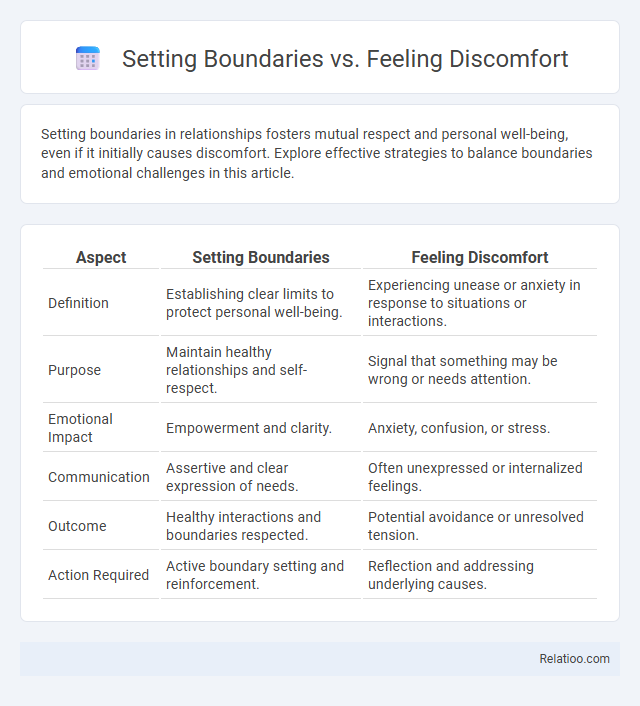Setting boundaries in relationships fosters mutual respect and personal well-being, even if it initially causes discomfort. Explore effective strategies to balance boundaries and emotional challenges in this article.
Table of Comparison
| Aspect | Setting Boundaries | Feeling Discomfort |
|---|---|---|
| Definition | Establishing clear limits to protect personal well-being. | Experiencing unease or anxiety in response to situations or interactions. |
| Purpose | Maintain healthy relationships and self-respect. | Signal that something may be wrong or needs attention. |
| Emotional Impact | Empowerment and clarity. | Anxiety, confusion, or stress. |
| Communication | Assertive and clear expression of needs. | Often unexpressed or internalized feelings. |
| Outcome | Healthy interactions and boundaries respected. | Potential avoidance or unresolved tension. |
| Action Required | Active boundary setting and reinforcement. | Reflection and addressing underlying causes. |
Understanding Boundaries: Definition and Importance
Setting boundaries involves clearly defining personal limits to protect emotional and physical well-being, which is crucial for healthy relationships and self-respect. Understanding the distinction between boundaries and discomfort is essential; boundaries are intentional and necessary, while discomfort may arise when confronting or establishing those limits. Recognizing and respecting boundaries reduces emotional exhaustion, enhances communication, and fosters mutual respect in interpersonal interactions.
Discomfort vs. Boundary Violations: Key Differences
Discomfort arises as an internal signal indicating unease or emotional distress, while boundary violations occur when others overstep limits you've clearly established, infringing on your personal space or values. Recognizing the difference helps you identify when to assert your boundaries firmly versus managing transient feelings of discomfort that do not necessarily imply a breach. Understanding these distinctions empowers your ability to protect your well-being effectively and maintain healthy relationships.
Signs You Need to Set a Boundary
Signs you need to set a boundary include persistent feelings of discomfort, resentment, or exhaustion in interactions with others. Your emotional or physical limits are often ignored, leading to stress or anxiety when you sacrifice your needs to please others. Recognizing these signals helps you protect your well-being by clearly defining and maintaining healthy boundaries.
Why Setting Boundaries Can Feel Uncomfortable
Setting boundaries can feel uncomfortable because it challenges existing relationship dynamics and triggers fear of rejection or conflict. Your brain associates boundary-setting with potential emotional discomfort, making it difficult to assert needs despite their importance for mental health. Embracing this discomfort is essential for establishing healthy limits that protect your well-being and foster mutual respect.
Common Myths About Boundaries and Discomfort
Common myths about setting boundaries include the belief that it causes rejection or that discomfort always signals failure. Many assume discomfort means something is wrong, yet it often reflects natural growth and self-assertion during boundary-setting. Understanding that discomfort can be a positive sign helps dismantle fears and promotes healthier relationships.
Emotional Responses: Guilt, Fear, and Growth
Setting boundaries often triggers emotional responses such as guilt and fear, as individuals may worry about disappointing others or facing conflict. Feeling discomfort is a natural part of this process, signaling personal growth and the development of healthier relationships. Embracing these emotions helps build resilience and strengthens one's ability to maintain clear, respectful boundaries.
Healthy Boundary-Setting Techniques
Setting healthy boundaries involves clearly communicating personal limits while respecting others, which promotes mutual understanding and reduces resentment. Feeling discomfort is a natural response when establishing these boundaries, signaling necessary personal growth and reinforcing self-respect. Effective boundary-setting techniques include assertive communication, recognizing emotional cues, and consistently reinforcing limits to maintain mental and emotional well-being.
Navigating Pushback and Reactions from Others
Setting boundaries often triggers discomfort not only within ourselves but also in others, leading to varying reactions and pushback that require careful navigation. Recognizing emotional responses such as guilt, frustration, or defensiveness allows for clearer communication and reinforces the importance of maintaining personal limits. Developing resilience and assertiveness helps manage external pressure while preserving healthy relationships and self-respect.
Practicing Self-Compassion During Boundary Setting
Setting boundaries often triggers discomfort, signaling your emotional limits need protection. Practicing self-compassion during this process helps transform discomfort into growth by acknowledging your feelings without judgment. Embracing kindness toward yourself fosters resilience and clarity, making boundary setting a sustainable and empowering habit.
Empowerment Through Boundaries: Long-Term Benefits
Setting boundaries empowers you by creating a clear framework that protects your emotional well-being and fosters healthy relationships. While discomfort may arise initially, consistent boundary-setting cultivates resilience and self-respect over time. The long-term benefits include enhanced personal growth, reduced stress, and a stronger sense of autonomy.

Infographic: Setting Boundaries vs Feeling Discomfort
 relatioo.com
relatioo.com